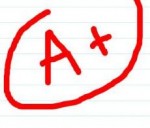
Beginning this semester, students can be graded on a scale that recognizes not only an ‘A’, but an ‘A+’ as a valid grade. The system was initially proposed by the Student Government Association in the 2007 fall semester, and was approved by the Faculty Senate on Apr. 17, 2008. Last semester, Chancellor Bardo signed his approval and programming was done to ensure that school computers acknowledged the ‘A+.’ The ‘A+’ was suggested by SGA as a way to make transcripts and resumes more impressive, and to reward students who put forth extra effort in a class. It is to be the “gold star” of letter grades.
The new grade will have no impact on GPA and is completely honorary. Some professors may adjust grading scales to accommodate this.
“If a particular professor, for example, designated that any grade from a 93 to a 100 counts as an ‘A,’ they may chose to make a 96 and above equivalent to an ‘A+’,” explained Associate Provost Beth Tyson-Lofquist.
Professors will not be required to give this grade, however.
SGA had considered using a form of the ‘A+’ system that some, although few, North Carolina schools have accepted. In this system, an ‘A+’ is assigned a value higher than a 4.0. Western’s administration was hesitant to accept that proposal though because it is compatible with so few other universities. This system can also lead to a sort of “grade inflation,” where something above a 4.0 at a school using the program becomes roughly viewed as equal to a 4.0 at another school that has not implemented it. This spirals all the way down the chain of grades, giving the overall impression that schools that offer the higher GPA assess students by a lighter standard. The end result is that it can simply make a university look bad.
Since the plus and minuses have long been accepted as valid with all other letter grades, the ‘A+’ system may make Western’s grading system much more consistent overall.
According to the University Registrar, school transcripts have already been adjusted for the new ‘A+’. The University ordered new transcript paper, and on the back of every transcript, there is an explanation of what the ‘A+’ means (along with explanations of all other possible grades). There is no date on transcripts to signify when the switch to ‘A+’ was made, however, so the transcripts of students who attended prior to the switch will give no clear indicator. The system is also not retroactive; an ‘A’ that was previously on a transcript will stay an ‘A’, with no explanation nor numerical value about why it is not an ‘A+’. Any students who would like to express concerns about how this will affect their transcript or grades are asked to contact the Registrar or Provost’s office.
(Student Government Association and Faculty Senate board meeting minutes were used to comprise portions of this story.)






